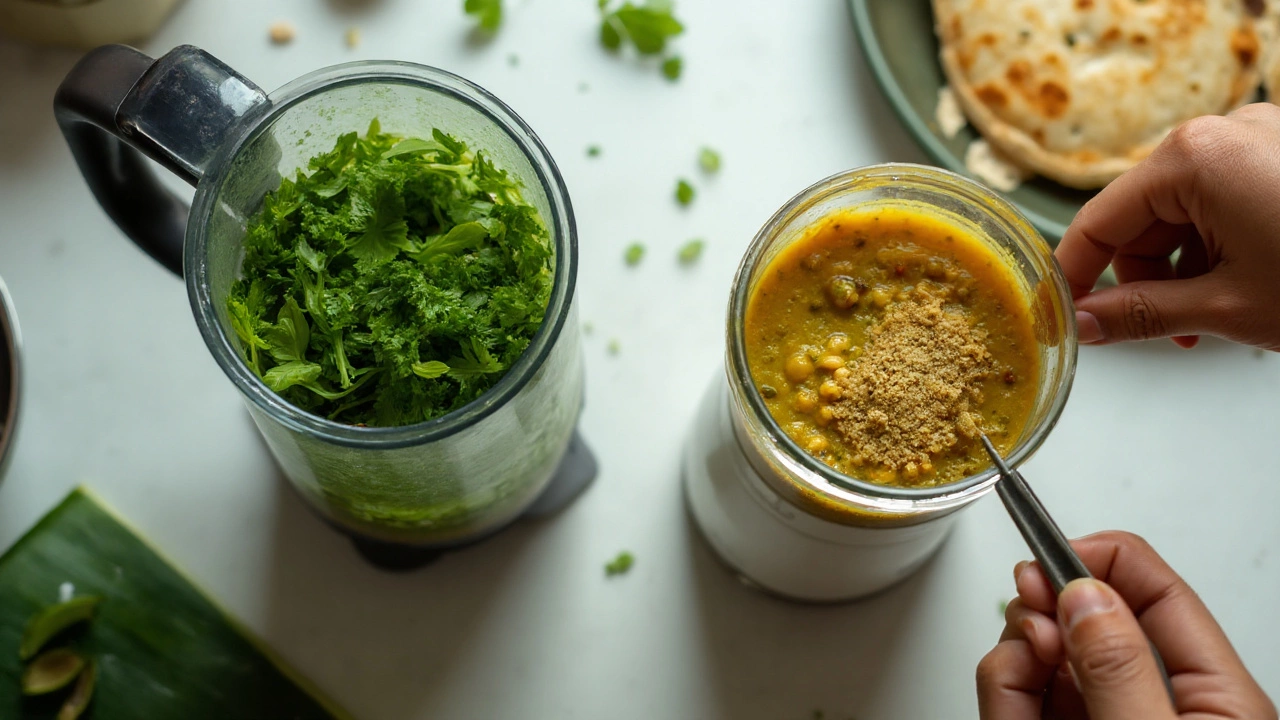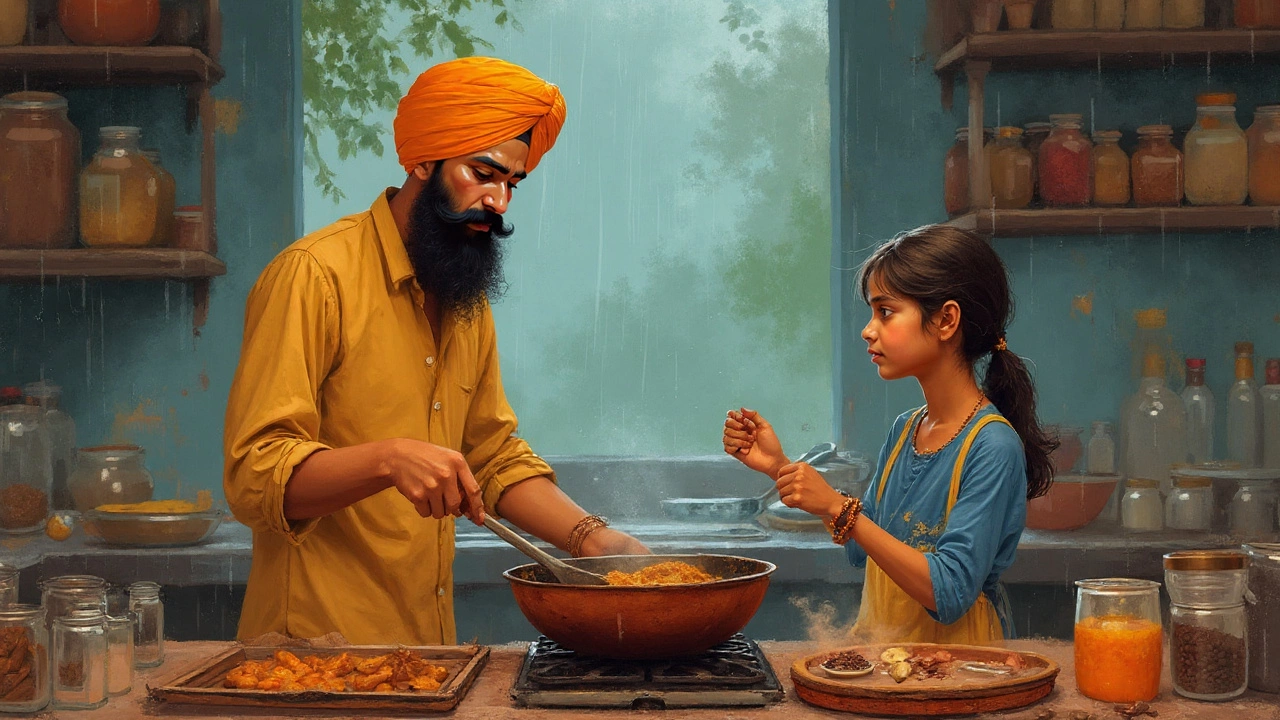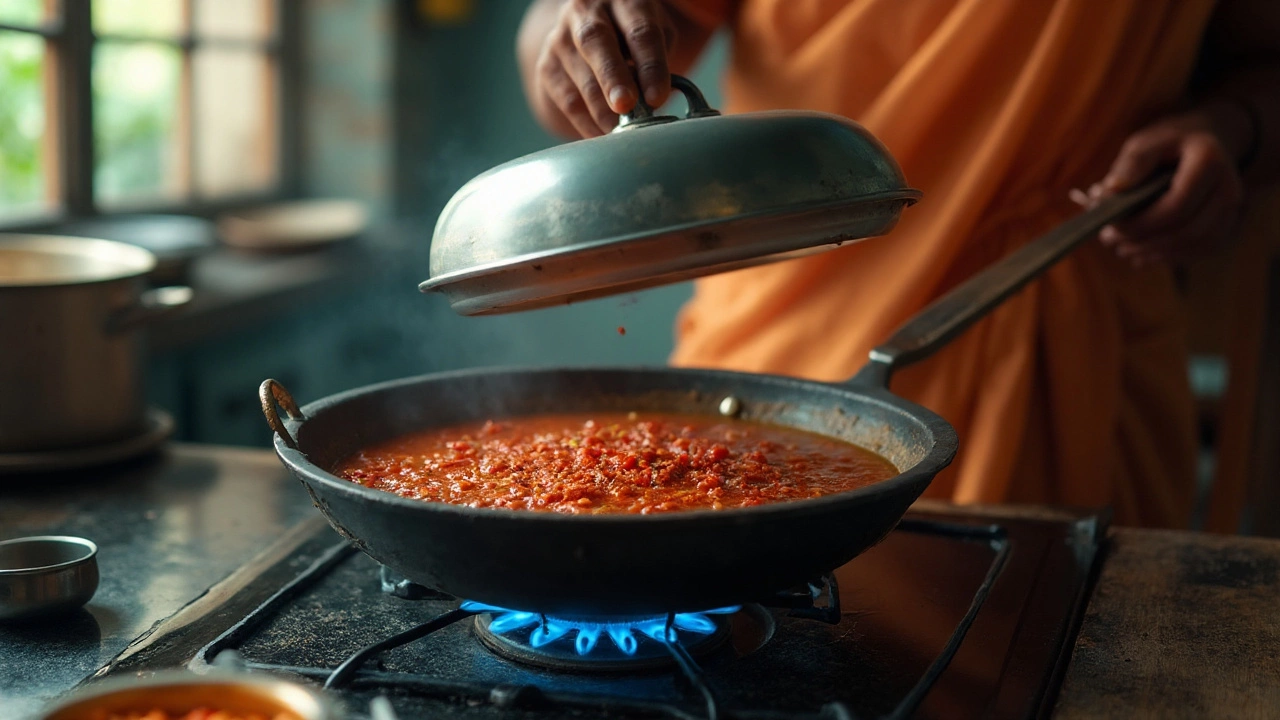One little lid can change your chutney from bright and punchy to dull and watery. If you’ve ever wondered whether to keep the lid on or off, you’re not alone. Here’s the short, practical answer plus a clear decision guide that works for Indian-style fresh chutneys and long-simmered fruit chutneys (think apple, feijoa, tamarillo). This isn’t theory; it’s the stuff that actually stops splatter, locks in aroma, and gets you the right thickness.
- Key takeaways: For fresh herb/coconut chutneys: don’t cook; temper uncovered. For quick cooked chutneys (tomato/peanut/onion): soften briefly covered, then reduce uncovered. For long-simmered fruit chutneys: mostly uncovered for evaporation; lid on only to soften early or control splatter.
- Rule of thumb: If you need to thicken or intensify flavour, go uncovered. If you need to soften or prevent messy sputters for a few minutes, partially cover or tilt the lid.
- Best pot: Use a wide, shallow pan for faster reduction; tall pots trap steam and slow you down.
- Food safety: Fresh chutneys live in the fridge. Shelf-stable jarred chutneys need tested recipes with correct sugar/acid; follow guidance from USDA and New Zealand MPI for safe preserving.
- Fast fix: Watery chutney? Simmer uncovered over low heat and stir often. Too thick? Loosen with a splash of hot water or vinegar to taste.
If you only remember one line, here it is: when in doubt about chutney covered or uncovered, reduce uncovered.
Quick answer and lid decision guide
Not all chutneys are cooked the same. There are two broad families:
- Fresh, quick chutneys (coconut, coriander-mint, peanut, onion-tomato sauté): often no cooking, or very short cooking plus a quick tempering (tadka). These are about freshness and pop.
- Cooked, preserved chutneys (apple, feijoa, tamarillo, mango, tomato-onion with sugar and vinegar): longer simmer to thicken and balance sweet-sour-spice. These are about body and shelf life.
Use this simple decision guide.
- Want to thicken or intensify flavour? Go uncovered to let steam escape. That’s how you reduce water content and concentrate taste.
- Ingredients need softening first (onion, apple, feijoa)? Cover for 5-15 minutes on low to gently steam. Then uncover for the rest of the cook so it reduces properly.
- Dealing with splatter (tomato, sugary fruit)? Partially cover: set the lid ajar or tilt it. You’ll control mess while still venting steam.
- Tempering (mustard seeds, urad dal, curry leaves)? Always uncovered so the spices bloom and stay crisp.
- Fresh herb chutneys (coriander, mint)? Don’t cook them covered or uncovered-blend raw and keep cold for colour and aroma.
Quick sanity checks:
- Condensation on the lid drips back and waters chutney down. If you see water beading under the lid, it’s time to uncover.
- Wide pan = faster thickening. Tall narrow pot = more steam trapped, slower thickening.
- If the chutney looks glossy and mounds softly when you push it with a spoon, it’s close to ready. If it spreads like soup, you need more uncovered time.
Step-by-step: cook each chutney the right way
Below are common chutney types you’ll actually make at home, with lid guidance, thickness cues, and time ranges. I’ll stick to practical kitchen signals, not just minutes.
Fresh coconut chutney (South Indian style)
- Blend: Fresh or frozen grated coconut, roasted chana dal (pottukadalai), green chilli, ginger, salt, and enough water to move the blades. Optional: a small piece of ice while blending keeps it cool and white.
- Tempering (uncovered): Heat oil; add mustard seeds, split urad dal, dried red chilli, curry leaves. When mustard pops and dal turns gold, pour the temper over the chutney. No lid here-crisp temper is the point.
- Do not cook the chutney: If you warm or cover it, you risk a greasy, split texture and a dull flavour. Keep it cold. Fridge life: 2-3 days max. For longer, freeze in small tubs.
Coriander-mint (green) chutney
- Blend: Coriander, mint, green chilli, garlic, lemon/lime juice, salt, a pinch of sugar. Add a splash of cold water or yogurt for body if you like.
- Zero cooking: Heat kills the bright green and makes it grassy-bitter. No lid, no simmer. Store cold; make fresh often.
Peanut chutney (Andhra/Karnataka style)
- Dry-roast peanuts uncovered until golden and nutty. Rub off skins if you like.
- Sauté aromatics uncovered: little oil, onion or garlic, green or dried red chilli. Soften without a lid so moisture cooks off.
- Blend with salt, tamarind, and water. Finish with uncovered tempering (mustard, urad dal, curry leaves).
- Texture check: It should sit on a spoon, not pour like milk. If too loose, grind in a few more roasted peanuts or simmer it briefly uncovered on low, stirring.
Onion-tomato chutney (quick stove-top)
- Start uncovered: Heat oil. Sauté onions with salt until translucent and sweet. Keeping the pan uncovered drives off water and builds flavour.
- Tomatoes in: Add chopped tomatoes and chilli. If the pan is very dry and you want a quick soften, cover for 2-3 minutes on low. Then remove the lid.
- Reduce uncovered: Cook until the mix looks jammy, oil beads at the edges, and a spoon dragged across leaves a brief trail.
- Blend or keep rustic. Finish with an uncovered temper if you enjoy that extra crackle.
Tamarind-date (imli-khajur) chutney
- Simmer tamarind pulp, chopped dates (or jaggery), water, chilli, and roasted cumin on low.
- Uncovered for reduction: You want a pourable but clingy consistency-think warm honey. Bubbling can spit; set a lid slightly ajar if needed, but keep a vent.
- Strain for smoothness and return to the pan. Adjust salt and sour, then cook a few minutes more uncovered until glossy.
- Cool before bottling for the fridge. It thickens as it cools.
Long-simmered fruit chutneys (apple, feijoa, tamarillo, mango)
- Combine fruit, onion, spices, sugar, and vinegar in a wide, heavy pan.
- Softening phase: Cover and cook on low for 10-15 minutes until the fruit slumps. This prevents scorching early on.
- Reduction phase: Remove the lid and simmer gently. Stir often, scraping the bottom and sides. Aim for a slow “plop,” not a fierce boil. If it spits, tilt the lid a touch; keep a good vent.
- Doneness cues: The chutney looks glossy, not watery. Drag a spatula across the base-if the trail holds for a few seconds before closing, you’re close. Drop a bit on a cold plate; if it wrinkles slightly when you push it, it’s set. A thermometer at sea level reads about 105°C when high-sugar chutneys and jams reach their gel point (your kitchen in Wellington is basically sea level-handy).
- Jar only if using a tested recipe. If you’re not canning, cool and refrigerate. Flavour improves after a week.
Typical timings (very rough, because pans and heat differ):
- Fresh coconut/green chutneys: No cook, 10 minutes total including tempering.
- Onion-tomato chutney: 20-30 minutes, mostly uncovered.
- Tamarind-date chutney: 25-40 minutes, uncovered or partially covered.
- Fruit chutneys for storing: 60-90+ minutes, lid off after the first 10-15 minutes. Wide pans finish faster.

Examples, rules of thumb, and practical checklists
Here’s the fast way to decide lid position for common chutneys, with the why behind it.
- Coconut chutney: No cooking; temper uncovered. Why: Heat splits the emulsion, dulls flavour, and shortens fridge life.
- Green coriander-mint: No cooking. Why: Heat browns chlorophyll and kills that fresh garden snap.
- Peanut chutney: Sauté uncovered, then blend; temper uncovered. Why: You want nuttiness and reduced moisture.
- Onion-tomato: Brief cover to soften, then uncovered to thicken. Why: You’re chasing jammy body without watery drips.
- Tamarind-date: Uncovered or tilted lid. Why: Needs evaporation; splatter control is the only reason for a partial lid.
- Apple/feijoa/tamarillo: Cover only to soften first, then uncovered to reduce to “set.” Why: A closed pot traps steam and stalls thickening.
Gear and heat that make this painless:
- Use a wide, heavy pan (24-28 cm). Surface area is your friend for reduction.
- Keep heat low to medium-low. Gentle bubbles reduce water without catching the sugars.
- Stir on a schedule: Every 2-3 minutes for quick chutneys; every 5 minutes for fruit chutneys at a gentle simmer. More frequent near the end.
- Splatter fix: Tilt the lid or use a mesh splatter guard-steam escapes, mess stays down.
- Measure reduction by weight or marks: Weigh the pot before and after or mark a wooden spoon with a rubber band where the level starts; stop when it drops to your target band.
Thickness targets that actually help:
- Fresh chutneys (coconut/green): Spoonable, like thick yogurt. They’ll thicken in the fridge a little; adjust with cold water.
- Quick tomato/onion: Soft mounds that briefly hold shape when you push with a spoon.
- Fruit chutneys: Spreadable but chunky. A spoon dragged across the pan should leave a few seconds of visible track.
Safety notes if you plan to store on a shelf, not just the fridge:
- Acid and sugar matter. Preserved chutneys rely on adequate vinegar (usually 5% acidity) and sugar ratio to be safe if canned.
- Use tested recipes and approved methods. Reference: USDA Complete Guide to Home Canning and New Zealand Ministry for Primary Industries guidance on home food preservation.
- If you’re not canning: Cool, jar, and refrigerate. Most cooked chutneys keep 2-3 months in the fridge; always use a clean spoon.
- Fresh herb/coconut chutneys are not for canning. Keep refrigerated and eat within 2-3 days; freeze extras.
NZ-specific favourites and how to lid them:
- Feijoa chutney: Start covered 10 minutes to soften, then uncovered to reduce to a glossy spoonable mass.
- Tamarillo chutney: Tomatoes love to spit-tilt the lid for the first 10 minutes, then fully uncover once calmer.
- Stone fruit (Central Otago apricots/plums): Mostly uncovered; add a splash of vinegar early and stir gently to prevent catching.
Mini‑FAQ and troubleshooting
Why did my chutney stay watery even after 40 minutes?
Likely causes: a tall pot, a tight lid, or heat that’s too low to keep steam moving out. Fix it by switching to a wider pan, uncovering, and keeping a steady gentle simmer. Stir more often near the end. Add a handful of finely diced apple (pectin-rich) for fruit chutneys-it helps thicken naturally.
Should I ever fully cover chutney?
Yes-but briefly. Use a lid to soften tough ingredients at the start or to calm wild splattering for a few minutes. Then uncover so moisture can escape. If you leave it covered, condensation drips back and you’ll chase thickness for ages.
How do I fix chutney that’s too thick?
Stir in hot water or hot vinegar (a teaspoon at a time) until it loosens to your liking. Recheck salt and sweetness.
My coriander chutney turned dark. Why?
Heat, time, and oxidation. Blend with something acidic (lemon/lime), keep it cold, and don’t cook it. Adding a few ice cubes while blending helps keep the colour bright. Store in a small jar with cling film pressed onto the surface to limit air contact.
Can I thicken coconut chutney on the stove?
You can gently warm it, but don’t simmer. Better fixes: add more roasted chana dal or a spoon of desiccated coconut, blend again, and adjust salt. Heat tends to split the coconut fat and make it greasy.
Is it safe to water-bath can chutney?
Only if you’re using a tested recipe with proper acid and sugar, and you follow processing times. Authoritative sources: USDA Complete Guide to Home Canning and New Zealand MPI advice for home preserving. Don’t guess acid levels.
Does altitude change anything?
Boiling temperatures drop with altitude. In most New Zealand kitchens near sea level, your gel-point target for high-sugar chutneys is ~105°C. If you live higher up, setpoint drops; rely more on visual tests (glossy look, spatula trail, cold-plate test).
How do I stop tomato chutney splatter without ruining reduction?
Use a mesh splatter guard or tilt the lid so steam can escape. Lower the heat to a gentle simmer and stir more often.
How long can I keep chutney?
Fresh herb/coconut chutneys: 2-3 days in the fridge; freeze up to 1 month. Cooked fruit/veg chutneys: 2-3 months in the fridge. Properly canned chutneys: follow the shelf-life guidance of the tested recipe you used.
Why does my chutney taste flat?
Often it needs acid, not salt. Add lemon juice or vinegar a splash at a time. Also consider sweetness-balanced chutney usually has a touch of sweet to carry spice and salt.
My chutney looks oily on top. Is that bad?
A little oil beading is normal for onion-tomato styles. If it’s excessive, your heat was high or you used too much oil; stir it in or spoon some off once cooled.
Can I use a pressure cooker or Instant Pot?
Pressure traps steam, so you won’t reduce well. Use pressure only to soften ingredients quickly, then transfer to a wide pan and finish uncovered on the stove.
Do spices bloom better with a lid?
No. Tempering relies on dry heat and quick frying. Keep it uncovered to capture that crackle and aroma.
What’s the best pan material?
Heavy stainless or enameled cast iron spreads heat evenly and resists scorching. Avoid very thin aluminium pans for sugary chutneys-they hot-spot easily.
Can I thicken without long cooking?
Yes: puree part of the cooked fruit, add finely diced apple (pectin), or stir in a spoon of ground roasted peanuts for savoury styles. Cook a few minutes uncovered after any addition to meld.
Does covering change colour?
Often it does-trapped steam can dull green chutneys and lead to a boiled look in tomato chutney. Uncover to preserve brightness and keep flavours clean.

Next steps and quick troubleshooting by scenario
If you clicked here wondering “lid on or off,” here’s your action plan for the most common situations.
- I’m making coconut chutney for dosa in 10 minutes: Blend cold and skip cooking. Temper spices uncovered. If too thin, blend in more roasted chana dal. Chill until serving.
- My onion-tomato chutney tastes raw and sharp: Cover for 2-3 minutes to soften the tomatoes, then uncover and cook until jammy. Add a pinch of sugar to round the acid.
- My tamarind-date chutney is splattering everywhere: Lower heat, tilt the lid to vent, and keep stirring every minute until the bubbles relax. Uncover fully to finish reducing to a syrupy flow.
- I’m making feijoa chutney from a bumper crop: Start covered for 10 minutes to soften, then uncover and simmer low until glossy and thick. Check balance: sugar, vinegar, salt. If canning, use a tested recipe and follow NZ MPI guidance.
- My chutney won’t thicken and dinner’s in 15 minutes: Switch to the widest pan you own, keep it uncovered, and stir steadily on a gentle simmer. For savoury styles, puree a scoop of the chutney and stir it back to thicken quickly.
- I accidentally over-reduced: Stir in hot water or vinegar a teaspoon at a time until the spoon leaves a soft trail. Taste and adjust salt/sweet.
Simple lid mantra you can trust: soften covered, finish uncovered. If you need thickening, keep steam escaping. If you need calm, tilt-don’t seal. That’s the whole game.
